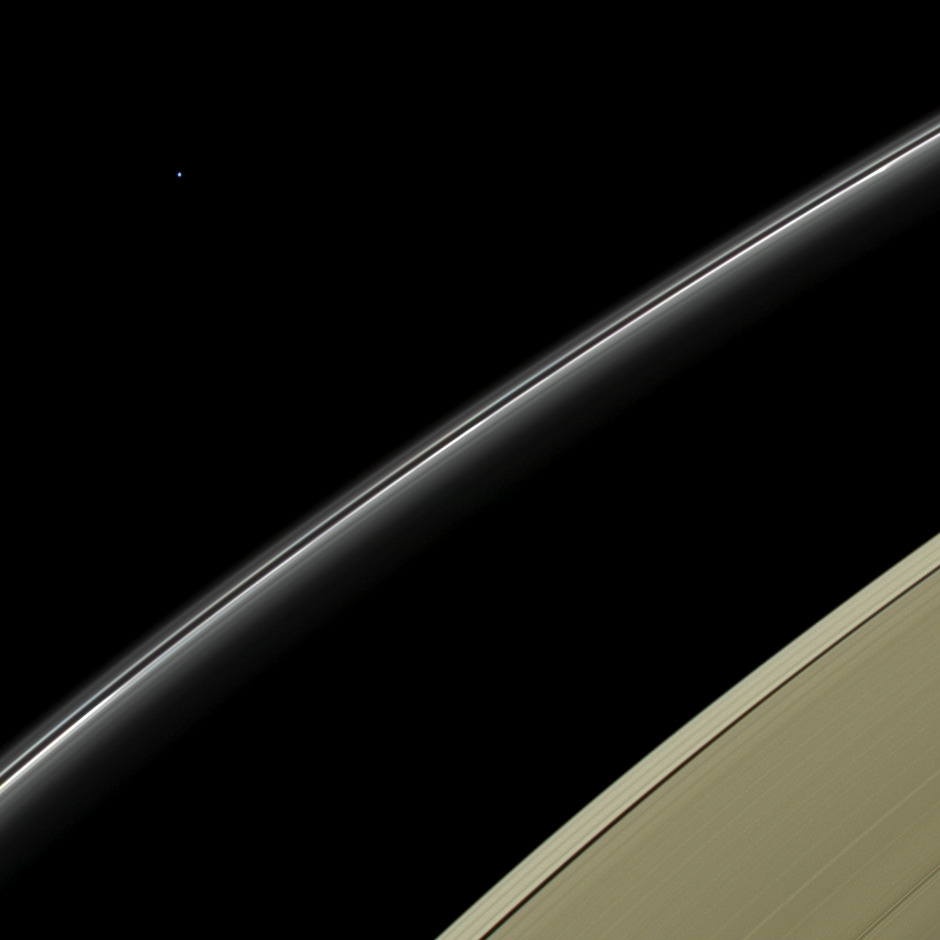When you hear the words “pale blue dot” you’re probably reminded of the famous quote by Carl Sagan inspired by an image of Earth as a soberingly tiny speck, as imaged by Voyager 1 on Feb. 14, 1990 from beyond the orbit of Pluto. But there’s another pale blue world in our Solar System: the ice giant Uranus, and its picture was captured much more recently by the Cassini spacecraft from orbit around Saturn on April 11, 2014.
Released today by the Cassini Imaging Team, the image above shows Uranus as a tiny blue orb shining far beyond the bright hazy bands of Saturn’s F ring.
“Do you relish the notion of being a Saturnian, and gazing out from the lofty heights of Saturn at the same planets we see here from the Earth?”
– Carolyn Porco, Cassini Imaging Team Leader
Uranus’ coloration is a result of methane high in its frigid atmosphere. According to the description on the CICLOPS site, “methane on Uranus — and its sapphire-colored sibling, Neptune — absorbs red wavelengths of incoming sunlight, but allows blue wavelengths to escape back into space, resulting in the predominantly bluish color seen here.”
This was also the first time Uranus had been imaged by the Cassini spacecraft, which has been in orbit around Saturn since 2004. In fact its ten-year orbital anniversary will come on July 1.
This image adds one more planet to the list of worlds captured on Camera by Cassini, which made headlines last fall when a glorious mosaic was released that featured a backlit Saturn in eclipse surrounded by its luminous rings, the specks of several of its moons, and the distant dots of Venus, Mars, and the Earth and Moon. Made from 141 separate exposures, the mosaic was captured on July 19, 2013 — known by many space aficionados as “the day the Earth smiled” as it was the first time the world’s population was alerted beforehand that its picture would be taken from over 900 million miles away.
Saturn — with its terrestrial spacecraft in tow — was about 28.6 AU away from Uranus when the image was acquired. That’s about 4.28 billion kilometers (2.66 billion miles). From that distance the glow of the 51,118-kilometer (31,763-mile) -wide Uranus is reduced to a mere few pixels (which required digital brightening by about 4.5x, as well.)
Read more on the Cassini Imaging Central Laboratory for Operations (CICLOPS) page here and in a news release from NASA’s JPL here.
Image credit: NASA/JPL-Caltech/SSI. Source: Carolyn Porco, CICLOPS Director


“Do you relish the notion of being a Saturnian, and gazing out from the lofty heights of Saturn at the same planets we see here from the Earth?”
I would add to Carolyn’s sentiments that we can also see “the same stars we see here from the Earth”. With that thought in mind I am reminded of a spectacular view of the globular cluster Omega Centauri (NGC 5139) seen far in the distance behind the F ring in this Cassini image: http://www.nasa.gov/mission_pages/cassini/multimedia/PIA12788.html